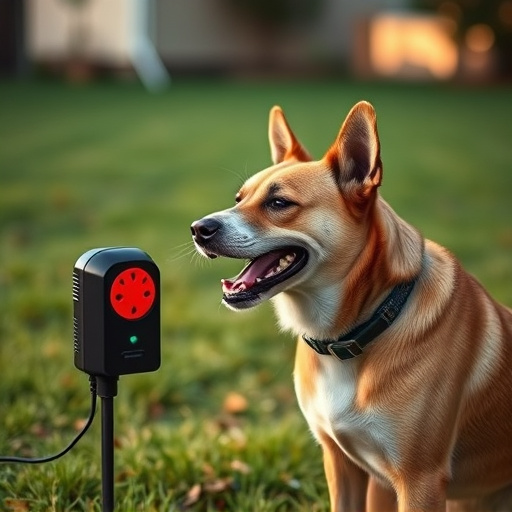Aggressive pet behavior, driven by fear, anxiety, and hormonal factors, can be addressed with modern ultrasonic dog deterrents using safe (22-52 kHz) ultrasonic frequencies. These devices target canine hearing without causing harm, effectively discouraging barking and aggression through adjustable sensitivity levels. Proper training is essential for optimal results, involving gradual exposure to the device in low-stress settings and rewarding calm behavior. Safe ultrasonic frequencies tailored for dog control offer a humane alternative to traditional punishment methods, promoting a safer and more effective approach to pet behavior management.
“Curious about taming aggressive pet behavior? This comprehensive guide explores an innovative solution: ultrasonic dog deterrents. We delve into the science behind these devices, revealing how they emit safe ultrasonic frequencies for canine control. Learn about identifying triggers and choosing the right device for your pet’s unique needs. Discover training tips for effective implementation, ensuring positive results without resorting to harsh methods. Understand the causes of aggression and explore a humane approach to restoring peace in your home.”
- Understanding Aggressive Pet Behavior: Causes and Consequences
- The Science Behind Ultrasonic Dog Deterrents
- Safe and Effective Ultrasonic Frequencies for Canine Control
- How to Choose the Right Ultrasonic Dog Deterrent Device
- Training and Implementation Tips for Positive Results
Understanding Aggressive Pet Behavior: Causes and Consequences
Aggressive pet behavior can stem from various factors, and understanding these causes is crucial in finding effective solutions. One common trigger is fear or anxiety, where pets may react aggressively as a defense mechanism when confronted with perceived threats. These could include loud noises, unfamiliar surroundings, or even other animals. Additionally, some dogs exhibit aggression due to territorial instincts, especially when protecting their food, toys, or resting areas. Hormonal changes, such as during puberty or mating seasons, can also play a role in unprovoked aggression.
The consequences of aggressive behavior can range from minor disturbances to significant safety hazards. It may result in damage to property, injuries to family members or other pets, and even legal issues. Traditional punishment methods like shouting or physical force can exacerbate the problem, as they often escalate the pet’s fear and anxiety. Instead, using safe ultrasonic frequencies for dog control offers a modern, non-invasive approach to deterring aggressive behavior without causing harm.
The Science Behind Ultrasonic Dog Deterrents
Ultrasonic dog deterrents work by emitting high-frequency sound waves that are inaudible to humans but can be irritating to dogs. These sounds, typically within the 25,000 to 60,000 Hz range, are designed to trigger an instinctive response in canines, causing them to avoid the area associated with these frequencies. The science behind it is based on understanding canine behavior and their acute hearing. Dogs have a much wider frequency range of hearing than humans, making them sensitive to sounds that we cannot detect. By using safe ultrasonic frequencies for dog control, these devices can effectively discourage aggressive or unwanted behaviors without causing harm.
The technology ensures that only dogs can perceive the sound, as humans typically cannot hear it. This specificity makes them a humane alternative to traditional deterrent methods. Moreover, modern ultrasonic dog deterrents are designed with multiple settings and adjustable sensitivity levels, allowing for customization according to different dog breeds and their varying sensitivities.
Safe and Effective Ultrasonic Frequencies for Canine Control
When considering an ultrasonic dog deterrent, it’s crucial to understand that not all frequencies are created equal. For safe and effective canine control, devices should operate within specific ultrasonic frequency ranges. Typically, products targeting dogs use frequencies between 22-52 kHz, well above the human hearing range of 20 Hz – 20 kHz. This high-frequency sound is designed to disrupt an animal’s behavior without causing physical harm.
Within this range, some devices focus on the lower end (22-32 kHz) as these frequencies have shown effectiveness in deterring dogs from barking and aggressive behaviors. However, it’s essential to choose a product that adjusts frequency levels for different dog sizes and sensitivity, ensuring safety and efficacy across various breeds and temperaments.
How to Choose the Right Ultrasonic Dog Deterrent Device
When selecting an ultrasonic dog deterrent, prioritize safety and effectiveness. Look for devices that emit safe ultrasonic frequencies specifically designed for dog control, typically ranging between 22-52 kHz. These frequencies are inaudible to humans but can effectively startle dogs, encouraging them to avoid specific areas.
Consider factors like range, sensitivity controls, power options, and weather resistance. A device with adjustable settings allows you to customize the ultrasonic intensity based on your dog’s reaction and environment. Ensure it’s suitable for indoor or outdoor use depending on where you need protection.
Training and Implementation Tips for Positive Results
When implementing an ultrasonic dog deterrent, proper training is key for positive results. Start by introducing the device in a low-stress environment, allowing your pet to become familiar with the sound without triggering it. Reward calm behavior near the device using treats and praise. Gradually increase exposure over time, moving closer to the detector as your dog becomes more comfortable. This desensitization process helps prevent fear or aggression towards the device.
For best effectiveness, use ultrasonic frequencies specifically designed for dog deterrence (typically between 25-64 kHz), well above the human hearing range. Ensure the device is activated only when your pet approaches, as constant activation can cause stress. Keep the detector out of reach to prevent destructive behavior or accidental activation. Regularly test the device and batteries to ensure it remains functional and effective in deterring aggressive responses from your pet.
When considering an ultrasonic dog deterrent, understanding both pet behavior and the science behind these devices is key. By choosing the right device and employing effective training methods, you can achieve safe and positive canine control. Remember, consistent use and patience are essential for success. Incorporating these strategies into your approach ensures a calmer environment for both your pet and your family while leveraging the benefits of safe ultrasonic frequencies for dog control.
